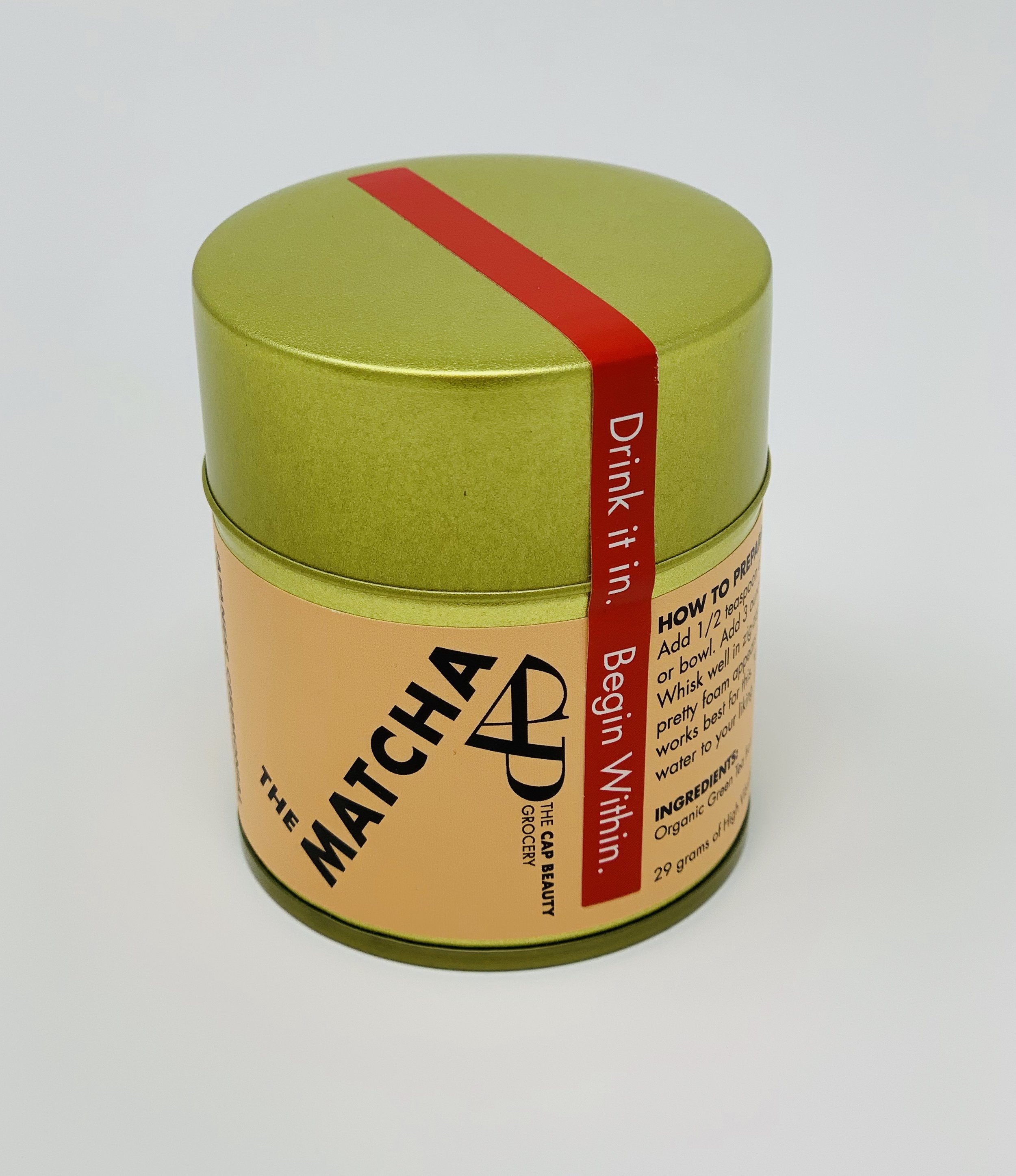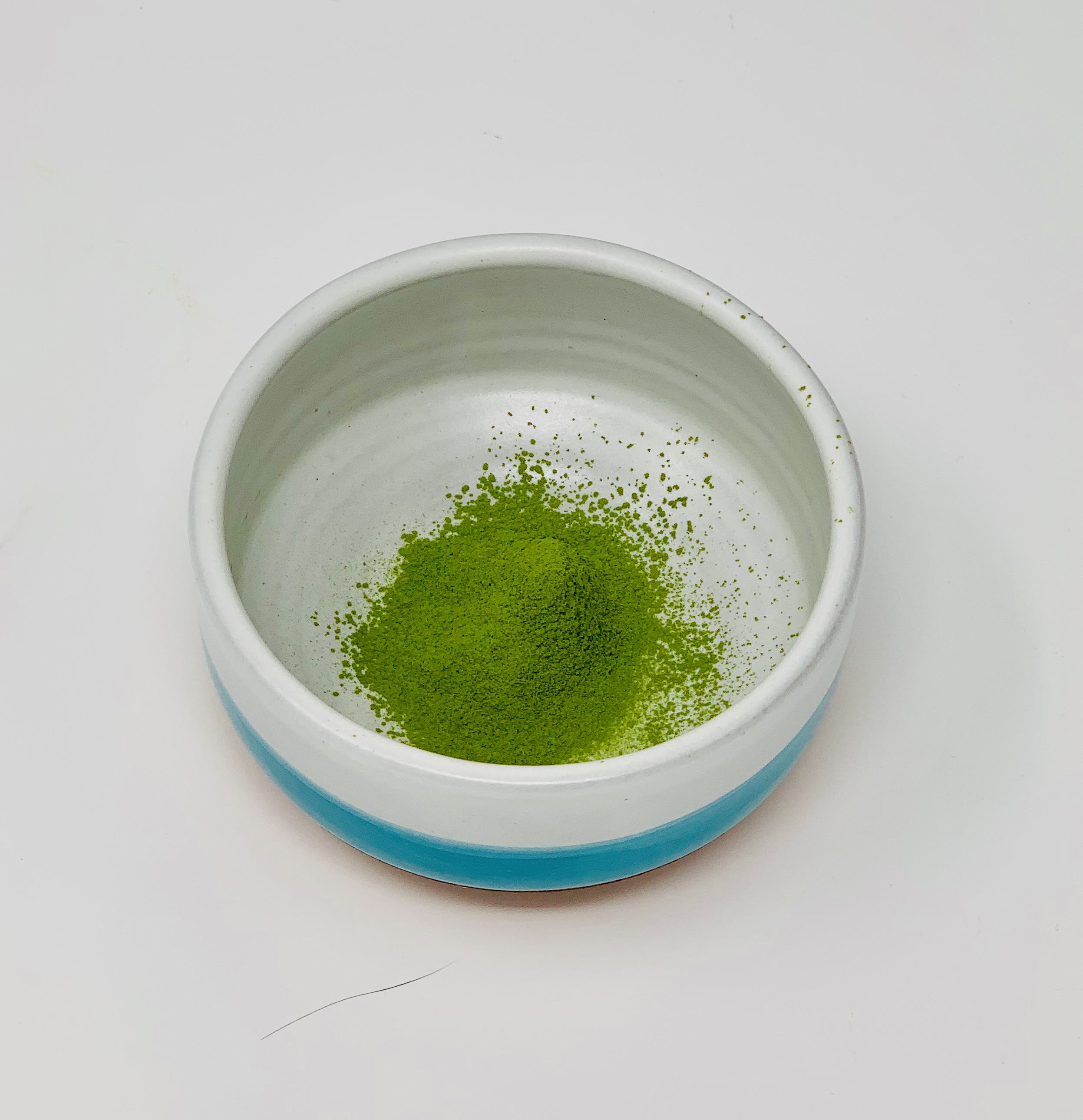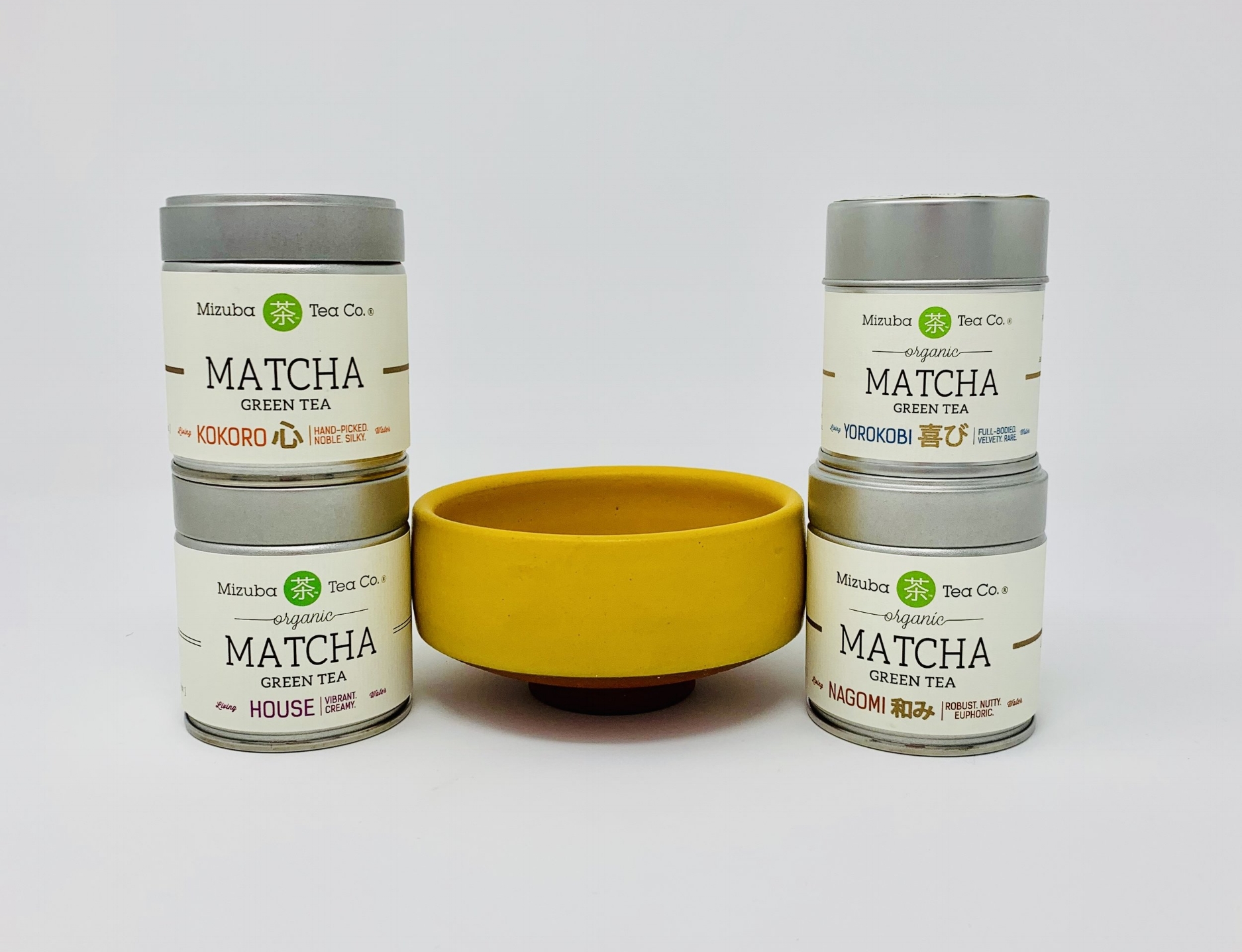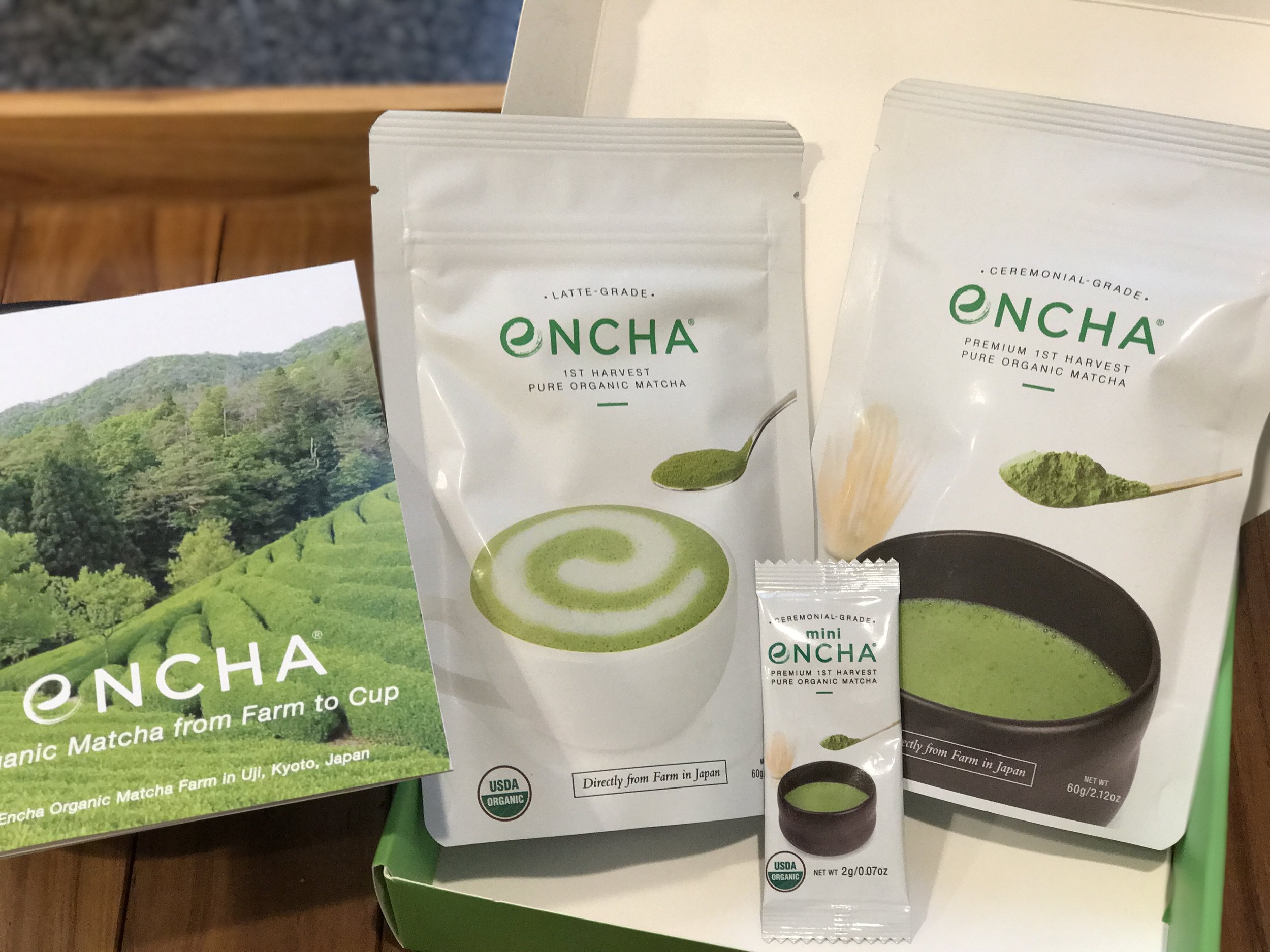
Drink it in. Begin within.
Well, my first gift for this Chanukah 2018 was perfect for me - a brand of matcha (and company) that was new to me - the organic The Matcha from CAP Beauty.
CAP Beauty is dedicated to the philosophy that “Beauty is Wellness. Wellness is Beauty” so the intent is that all their 150+ products create “true radiance.” The fact that their products are “100% natural” resonants with me, as does the recognition of plant based medicine on their website, which speaks about the power of the plants to heal, since they are “teeming with nutrition and life force.”
Of course, the label is the first thing to catch the eye, and I find it just plain uplifting, making me smile. The red label on the side of the tin says, “Drink it in. Begin within.” That accurately sums up my meditation and matcha practice - make matcha and meditate. Well, the meditation actually begins with the making of the matcha. How matcha goodness is contained within this tin - that would be “29 grams of High Vibrational Focus.” Who can argue with that?
For an organic matcha, this one is fairly good. The matcha sifts nicely, and is a lovely bright green, though not as vibrantly emerald as I have seen in many non-organic brands. My koicha whisked easily into a thick and creamy elixir, while the addition of more water to whisk an usucha produced a bowl with a thin layer of foam with sparse bubbles. The aroma was fresh and grassy. The texture was very slightly gritty, but not unpleasant at all. I did prefer the flavor profile of the koicha to the usucha, yet despite the slight bitterness common with organic matchas, this dissipated quickly to leave a umami finish that lingered for quite some time. The overall flavor was clean but not very sophisticated or complex. For an organic matcha, I readily recommend it. Once you explore their website, you might find yourself purchasing other products, as I did. I just couldn’t resist ordering their matcha coconut butter.
Taking a Matcha Moment with Mizuba Matcha
For me, every day begins with a meditation and matcha moment (well, that is, after the cats have been fed and petted). My intent on this Thanksgiving was to do an extended gratitude meditation, giving thanks for all the people and experiences in my life. This began when I acknowledged how fortunate I am to not only be writing this blog, but to have the opportunity to meditate and drink matcha in the safety and serenity of my own home. I hope to never take that for granted.
Before sitting on my cushion to practice opening my heart, I opened my new package from Mizuba Tea Company. I discovered Mizuba through their trademark saying - Take a #matchamoment. I clicked the link to their website without a moment’s hesitation. On a quest to discover the best tasting organic matcha available, I had planned a purchase, yet landing on their chawan page, I was a goner. My whole being brighten and smile erupt on my face seeing a vibrant yellow chawan. Before I knew it, four matchas managed to make their way into my shopping cart along with that yellow bowl.
For my morning meditation session, I began with their organic ceremonial Yorokobi matcha. Their description echoes my sentiments. Most organic matchas, as I have discussed previously, tend to be bit bitter and astringent, making the overall experience less than a enjoyable. The translation for yorokobi is “joy” and as the name suggests, this matcha delights. The color was a vibrant green and whisking it lead to a think foam like froth. The aroma had a floral note. Today I whisked a thick, creamy, and velvety smooth koicha with nice umami finish. My senses awoke to the taste and I felt a soothing calm embrace as I sat down to give thanks. After appreciating my loved ones and cats, my students and patients, my colleagues and friends, my thoughts turned to all the hands that touched this matcha from the moment the seeds were planted to this very well designed package on my counter. How many hundreds, if not thousands, of people were involved? And I hadn’t yet gotten to the chawan. Thank you all for enriching my life.
Throughout the rest of day, I managed to try all the other matchas I received. Two others were also organic, the Nagomi and the House matcha. The Kokoro was not organic, but was just as smooth as the Yorokobi. It whisked quickly and to a full-bodied froth. This one was a even a bit more creamy and richer with a smooth chocolaty flavor. The organic Nagomi was delightful with a nuttier flavor and a clean umami finish that lingered on my tongue quite awhile. The description on the website for the organic house matcha talks of adding honey and pouring over ice (something I never do), and I know why. As a bowl of matcha, this was rather disappointing in its grittiness and bitterness. Most likely, I will use this for matcha lattes and cooking.
Did I mention how this yellow chawan delighted me? The color is enticing, as I have never seen a bowl this hue. I feel sunshine looking at this bowl, and the contrast of green and yellow is energizing. The glaze has a lovely thickness to the texture, not glossy. The size is perfect - not overly large as many chawan can be, as it fits neatly into your hand. I love this bowl and may buy a few more (oh, yes, for gifts, sure).
On this Thanksgiving, I was thrilled and thankful for finding these gems. If you are looking to take a (organic) #matchamoment, visit Mizuba today, and see if you can avoid temptation of buying a new chawan.
I highly recommend the entire experience.
Matcha Shiba - Organic Matcha from Japan
I am always on the quest for organic matcha, so thank you Matcha Shiba sending me both your Diamond Class and Everyday Class Matcha for tasting. For the record, I may be biased here. I have always wanted a shiba inu dog, so I smile every time I see their logo!
Matcha Shiba is certified organic in Japan (JAS - Japanese Organic Agricultural Standard, a fairly new certifying body established in 2000) and the US (USDA). The Diamond Matcha is bright green with a very slight, but fresh, vegetal aroma. Whether I made ushucha or koicha, it whisked easily and fully. With more water I could create a lovely thick frothy creama. The koicha had a wonderful consistency. I could detect a subtle umami flavor, but it was lighter than other brands I have had of late. To me, the Diamond Class was a bit more bitter than I prefer, and that note overpowered the umami finish initially. However, a minute or two later, the bitterness faded and a pronounced sweet and savory note came forth. Still, since this was organic matcha, I am pleased by the Diamond Class overall.
It is harder for me to critique culinary grades unless an overwhelmingly bitter taste comes forth in the food or lattes. After opening the Everyday Class package, which came in a resealable bag versus the metal, vacuumed sealed tin in which I received the Diamond Class, I was struck instantly by the contrast of color. The Everyday matcha was was flatter, duller and more on the yellowish side of green. The smell was less pronounced as well. After making a latte with pure organic coconut milk (from the can), the bitterness was fortunately minimized, and I will use it for my almond flour, paleo waffles and pancakes, as well as lattes and smoothies.
Thank you again, Matcha Shiba. As a daily matcha drinker, I am excited to have more sources of worthy organic matcha from which to choose..
Taking off with Matcha Flights from Breakaway Matcha
In my quest to try various brands, I was ecstatic that Breakaway Matcha offers matcha “flights” - a long, narrow box containing 4 different varieties of their matchas. Eager to experiment and taste, I ordered 2 flights, allowing me to sample 8 different varieties.
On his website and in interviews, founder Eric Gower says he created Breakaway after being unable, back in 2010, to find high quality matcha in the States, and I am glad he did.
How to best start my tasting experience? I almost sat down and tried all 8 blends when they landed on my doorstep, but I thought that might not be the best thing for my nervous system, so I settled to try two per day. Breakaway offers what they call Hyperpremium Blends supplied from various growers in Japan who are passionate about their matcha. The blends are either numbered (94, 95, 97 98. 99. and 100) or have names. Wanting to test the veracity of their website’s claim that the matcha becomes sweeter with a longer and more umami finish as the numbers increase, I purchased the top 4 numbered blends to compare (97, 98, 99, & 100). Selecting the second flight was a bit more daunting as I wanted to try them all. However, I knew I wanted to try their Hyperpremium Oganic Blend, so that left me with three other choices. Once I realized that I can always order another flight, I settled upon the blends called Rikyu, Hikari, and SE Blends.
Gower likens his matchas to purchasing top of the line wine from award winning vineyards whose premier bottles might sell for hundreds of dollars. While those same wineries may also produce more affordable blends for those who will spend no more than $20 to share with friends a meal, nothing can compare to those of higher quality. After tasting all of the blends in my flights, I agree. These are not your run of the mill, every day, grocery store, pseudo-ceremonial matcha blends, but something special.
I decided to breakaway from my traditional way of making matcha and follow Gower's suggestions - namely, using an electric whisk. I purchased one several months ago and have never been too fond of it. I now believe this has to do with the fact that I use my larger chawan (matcha bowls). Breakaway recommends (and sells) matcha tumblers, which are exquisitely stunning (and I am trying to hold back from purchasing all of them). Gower favors koicha, or thicker matcha, for consuming these blends, which I prefer. I believe the flavor is amplified and the experience is heightened. Making koicha with an electric whisk in my typical wide chawans is not very functional, so for these tasting experiences, I found a narrower bowl, and I lo and behold, the electric whisk worked. For each blend, I used about 1 - 2 grams of matcha for about 1 - 1.5 ounces of water.
Overall, these matchas are all visually enticing. As described on the website, they were all a bright, “hallucinogenic” green. Seeing that shock of bright color starts me salivating, knowing I am in for a quality experience. Nothing is more disappointing than opening a package of matcha to find a dull, flat green or yellowish-brown powder. Such blends never have anything but a pronounced bitter, astringent taste. Using my electric whisk created a nice, rich, thick creama for all of them. I experimented with different vessels and now believe that with an electric whisk, the width makes the difference: the wider the vessel, the more froth and foam with larger bubbles; the narrower the vessel, the more foamlike with sparser bubbles.
I enjoyed the lack of even the slightest astringency with any of the numbered blends, but notice a trace of it with the Hyperpremium Organic, yet I found it delicious. Each had a slight variations in umami, where it hit my tongue, intensity or amount of time of the finish. The mid-notes varied for each,and the sweetness, present in all, was in different levels of intensity. Still, all were excellent.
Choosing a favorite is challenging. Overall, what stands out to me regarding all the blends I sampled was how utterly smooth and creamy they were. Their aromas were light and not overpowering at all. Unfortunately, price point is a factor in matcha selection. Many of the blends are far more expensive than most higher quality matchas on the market. Since taste preference is a subjective and personal matter, cost does not always equate with quality or taste. However, of the numbered blends, I would select #100 ($109 per 30 grams) hands down due to its delightful creamy smoothness and absence of bitterness. The smell was fresh and grassy, with that chlorophyll scent that makes me think of a quiet, unhurried, and lazy summer afternoon. The finish lasted longer, and the umami taste was more in the front of my tongue than the lower numbers. While close in quality, they were less impressive to me only in comparison to Blend 100. I have yet to try Blends 95 ($59), 94 ($49) or 93 ($39), so I cannot speak to those (perhaps that is my next flight).
As for the other blends, a 30 grams tin range in price from $169 for Hikari to $149 for SE and $129 for Rikyu. My favorite, based on my small sampling was SE for its intense bright color, thickness, and creamy umami taste.
I plan to reserve Blend 100 and SE for special occasions or times I plan on deeper meditation, while the Hyperpremium Organic I will use for daily consumption.
The most affordable of those I tried was the Hyperpremium Organic at $59 for a 30 gram tin. Not as smooth as the others, and with a slight bitterness, I would definitely recommend this since it is still smoother and less astringent than many matchas I have tried that were close in price point. Hyperpremium is a great choice, especially for those who demand organic.
Since I only had the small jar flights, I wasn’t able to experiment with contrasting koichas with ushucha with each blend, however I had just was able to do with a few. Now all my jars are empty, so I am currently grounded for now. Once I order more, and yes, I will be ordering more, I hope to take off again.
Encha Matcha & Gratitude for Gaia
In my quest to try as many different matchas as possible, I visited the encha organic matcha website on the recommendation of a new Instagram friend, the tea blogger/teaaholic, Lu Ann Pannunzio of The Tea Cup of Life. Immediately, I fell in love with the story of Encha, and Li Gong, the founder. Li writes about his radical departure from his comfortable Silicon Valley job after tasting quality matcha in Uji, Japan. Instantly, he knew he had to change career paths, and found this company to share his passion and commitment for high-quality, non-GMO, organic, yet affordable matcha with the world. And we all can thank him for that.
Before I knew it, I ordered both the ceremonial and latte grades, as well as two chawans (matcha bowls) and an electric whisk (when I commit, I commit! Matcha and tea sellers, please don't take advantage of me!). After years of holding steadfast to my purist values, I was swayed by several videos claiming the benefits of the thickness, frothiness and flavor achieved from an electric whisk, so I had to compare it to my bamboo chasen.
Saving the latte grade for another time, I eagerly opened the resealable bag of ceremonial matcha. I made both a usacha and koicha (I prefer the intensity of flavors you get from koicha, but realize this is not for everyone). I first made the usacha. Using my bamboo chashaku, I scooped out two heaping spoonfuls into my new black chawan. The hue was a vibrant light green with a slight grassy aroma. Gently pouring in about 5 oz. of water (I prefer to use 170°F), I took hold of my new electric device and turned it on. Not knowing what I was doing, I moved it back and forth in the traditional "W" motion, causing the liquid to slosh and splash over the sides. Adjusting my movements to a simple back and forth "I" motion prevented any further loss of my precious elixir. To my surprise, the whisk created an incredibly thick froth. However, my novice technique yielded a few clumps at the bottom of the bowl. Fortunately, subsequent attempts proved less problematic, and all the matcha was thoroughly and easily mixed.
The taste is bright from the moment it lands on the tongue, slightly sweet and creamy with an umami flavor that remains on my tongue for several seconds, but was not overpowering at all. The koicha was even better - thick and creamy, slightly vegetal and ever so intoxicating. With my bamboo chasen it mixed easily and thoroughly. Truth be told, I made several bowls to taste and re-taste encha ceremonial matcha.
The next morning, I opened the latte grade and made a thick, creamy, and delicious almond milk latte. I very rarely use any of my ceremonial grade matchas to make a latte - in my mind that is a waste, since matcha-time is sacred and meditative, and lattes seem more mundane. However, now that I have tasted a home made latte made with an excellent quality matcha, I might be changing my tune. I find my salivating thinking of it right now.
As a naturopathic physician, I am concerned about the health of the Earth and all its inhabitants. I try to ensure that the matchas I sample, taste and drink on a daily basis are organic and free from pesticides and synthetic fertilizers. I am so grateful to all the of the tea farmers and distributors whom I see as the Earth's stewards, dedicated to growing sustainable and organic tea. Thank you.
As I sat down on my meditation cushion, I thoughts about Li's story, and how a sip of matcha changed the course and direction of his life. I offered gratitude to Mother Earth, to Gaia. I walk about you daily, partaking in all your riches. You give and give, and often I fail to honor and appreciate your gifts - like the gift of tea.
Exhaling, I allow myself to settle. The cushion is supporting me, while the floor holds up the cushion, as the foundation supports the floor, yet ultimately it is the Earth holding and supporting us all. Thank you for supporting us all, even when we overlook, ignore and disrespect you. Thank you, organic tea farmers, who are supporting the Earth and all of us in our path to health and wellbeing.


























